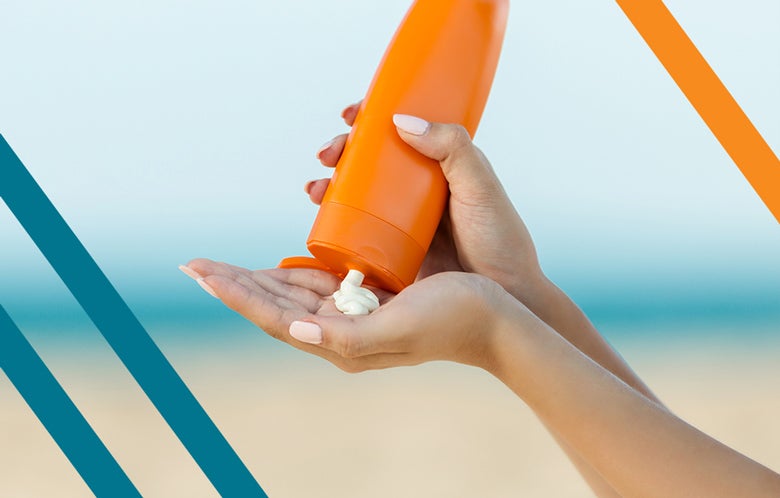Warmer weather often increases the amount of time a person spends in the sun. While sunshine can be beneficial, prolonged exposure can cause sunburn, premature skin aging and increased risk for premalignant and malignant skin conditions. However, use of sun protective methods such as sunscreen can mitigate these harmful effects. Here, we discuss five common questions about sunscreen.
When should sunscreen be worn?
Sun protection measures should be taken anytime skin is exposed to the sun, any time of year, and even on overcast days. Sunscreen with a minimum sun protective factor (SPF) 15 should be applied to ALL exposed skin including hands, feet, lips, and head (in people with little hair).
Sunscreen is not recommended for children younger than six months old; for children older than six months old, broad-spectrum sunscreen with SPF 30 or higher should be applied to all exposed skin.
While sunscreen is recommended for protection, no sunscreen completely protects against ultraviolet (UV) radiation, so multiple protection methods (clothing, seeking shade, wearing UV protective sunglasses) should be considered.
Is all sunscreen the same?
Not really. Sunscreen can vary in protection against both types of UV radiation (UVA and UVB rays). UVA has longer wavelengths that penetrate deep into skin and lead to irreversible damage contributing to skin aging and mutations associated with skin cancers. UVB, a shorter wavelength, typically causes sunburn. Broad-spectrum sunscreen is optimal to protect against the fuller range of effects.
Sunscreens vary in SPF level (the amount of sunburn protection from UVB but not UVA rays) with ranges from 15 to 100 SPF. But protection levels between SPF 15 and 100 are not greatly different – SPF 15 blocks 93 percent of UVB radiation and SPF 100 blocks 99 percent. While there is no specific rating system to identify UVA protection, if a sunscreen is labeled ‘broad-spectrum’ the UVA protection is proportional to the UVB protection.
Sunscreen also comes in a variety of forms. Creams and lotions are best for dry skin and the face. Gels can be helpful for oily skin or areas with hair. Sticks may be preferred around the eyes. And sprays are sometimes used for ease of application but may provide inadequate coverage. Some cosmetics and insect repellents contain SPF, but even if using these products, it is still important to apply sunscreen and reapply every two hours.
Are there any concerns about using sunscreen?
Small amounts of sunscreen may be absorbed systemically but the clinical significance of systemic absorption is unclear.
Some evidence has reported six active ingredients (avobenzone, oxybenzone, octocrylene, homosalate, octisalate, and octinoxate) in plasma concentrations that exceed the threshold determined safe for general use by the FDA (greater than 0.5 ng/mL). Several products have been recalled due to concerns about carcinogenic ingredients (benzene) in aerosol sunscreens, pointing to the need for further investigation into the potential effects of systemic absorption.
Subcutaneous absorption appears more of a concern with organic sunscreens. The FDA identified 12 organic sunscreen ingredients with insufficient evidence to deem them safe and effective. Inorganic sunscreens like zinc oxide and titanium dioxide, however, have been recognized as safe and effective by the FDA, but inorganic sunscreens leave a prominent white residue with application that may deter use.
Overall, the benefits of wearing sunscreen currently outweigh the harms.
Does sunscreen inhibit vitamin D absorption?
Maybe, but evidence that sunscreen limits absorption and synthesis of vitamin D is inconclusive. Most people need two to eight minutes of unprotected sun exposure to maximize synthesis of vitamin D3. Adequate levels of vitamin D can also be attained from food and beverages such as fatty fish (salmon, tuna), egg yolks, and vitamin D fortified foods.
Do people with darker skin or those who do not get sunburned need to wear sunscreen?
Yes, all skin phototypes can benefit from sunscreen.
Darker skin is less likely to burn and may not need as much UVB protection, however, darker skin is still susceptible to damage from UVA radiation. Sunscreen should have both an SPF of at least 30 with a UVA protection factor (UVA-PF) ratio of less than 1.5. [UVA-PF is a method to assess how protective sunscreen is against UVA radiation.]
Even for skin tones that usually tan more than burn, sunscreen is necessary. Tanning is a sign that the skin is reacting to UV radiation. Tanning produces pigmentation that may offer some protection against sunburn, but it is usually not as effective as using sunscreen.



